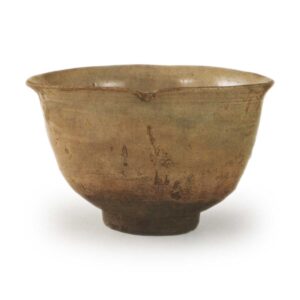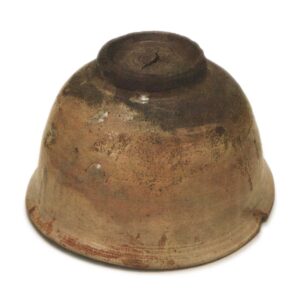

Height: 8.0cm
Diameter: 13.0cm
Outer diameter of foot: 5.3cm
Height of foot: 0.9cm
This is a famous bowl that was especially loved by Tokubei Oda, a collector of famous tea bowls and connoisseur of tea bowls in Nagoya during the Meiji and Taisho periods. This tea bowl is considered to be one of the Onikumagawa pieces because the style of its making is slightly rougher than usual, and in particular, the tone of the body glaze and the way the foot ring is made are particularly strong. Moreover, it is a unique piece that is different from other Onikumagawa pieces in that it has a rough, simple beauty, and yet also has a kind of broken elegance.
As promised, the rim is slightly large and has a slight outward curve. The rim is made with a natural, unplanned potter’s wheel technique, and the rim is made with a natural, unplanned potter’s wheel technique, and the rim is made with a natural, unplanned potter’s wheel technique, and the rim is made with a natural, unplanned potter’s wheel technique, and the rim is made with a natural, unplanned potter’s wheel technique, and the rim is made with a natural, unplanned potter’s wheel technique, and the rim is made with a natural, unplanned potter’s wheel technique, and the rim is made with a natural, unplanned potter’s wheel technique, and the rim is made with a natural, unplanned potter’s wheel technique, and the rim is made with a natural, unplanned potter’s wheel technique, and the rim is made with a natural, unplanned potter’s wheel In addition, the traces of the scraping can be seen clearly on the rough clay surface of the round curved surface that has been scraped from the foot to the body. In particular, the foot is carelessly made with the scraping left unfinished, and the center is offset and lopsided like a crescent moon, with the marks of the eyes dotted along the edge. And on the bottom, there is a large tear in the shape of the character “ku”, and the whole area around the foot ring is a strong, rough landscape.
The foot ring and the area around it to the waist are quite wide and bare. The coarse, dead soil has absorbed the tea stains from years of use, and this part is unusually dark. However, it is not an unpleasant stain, but a calm and deep taste that has been handed down through the ages. The true unglazed surface is rather light, with a yellowish tinge, and looks rather bright, as if you could see through the thin layer of glaze.
The glaze is transparent in places where it is thin, but in places where it is a little thicker, it is a dull, translucent grayish-blue. In one place, from the rim to the foot of the bowl, there is a beautiful bluish-gray glaze and a splash of glaze. In other places, the glaze is uneven in thickness and the glaze application is crude, so the color varies from pale yellow to reddish-brown to bluish-gray, and the glaze surface is complex and chaotic, with the addition of stains from previous owners. In addition, the inside of the bowl is deep and wide, and the tea-stain area forms a “mirror” as usual, with three sand-like patterns visible. There is also a leak-like stain, which looks even darker in the inside of the bowl. This tea bowl is also known by the nickname “Tachikaku” (Standing Crane), rather than by a specific name. This is because there is a small area of unglazed clay on the side of the bowl, and this has the shape of the crude crane pattern seen on the Irimo Hon-Ryakusu. Also, on the upper edge of this crane pattern, there is a small spout-like protrusion that hangs down in the shape of a lip. This is a particularly noticeable feature of this tea bowl, and it is thought that a small foreign object fell into the kiln during firing and hit this part, bending the rim and scratching the side of the bowl, leaving the crane-shaped mark. In other words, it is a rare mountain mark that was created by a small incident in the kiln. The people of the Yi Dynasty left it unintentionally, and our old wabi tea masters especially selected it out and prized it as a rare item.
It was passed down to the Kobe family of Nagoya, who were famous for collecting famous tea utensils, and it became even more famous when it came into the possession of Tokubei Oda. Since the Taisho era, it has changed hands a few times, and it is currently in the possession of a certain family in the Kansai region, having passed through the hands of the Tanimatsuya Toda family.



